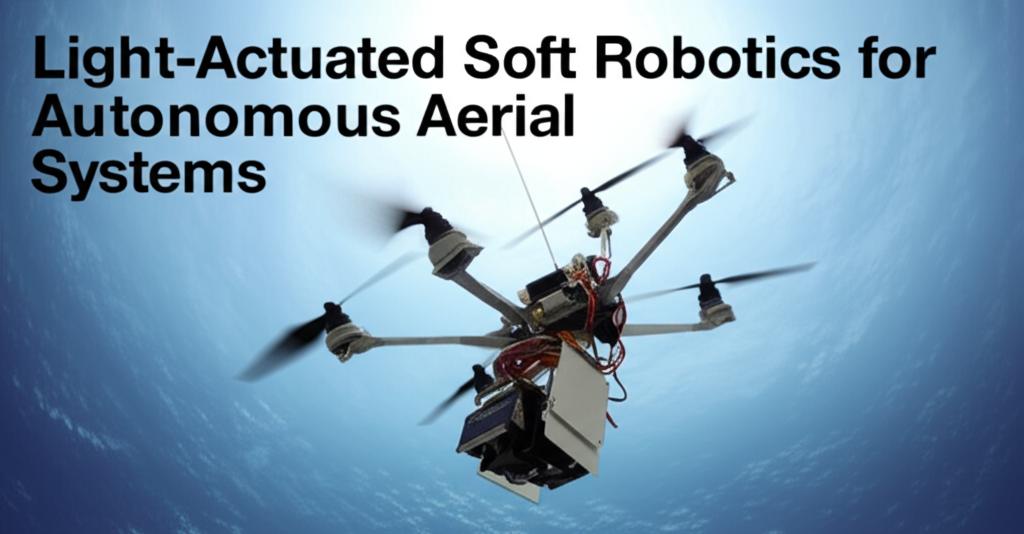Soft robotics represents a rapidly advancing field, drawing inspiration from biological organisms to create flexible, adaptable machines. Unlike traditional rigid robots, soft robots utilize deformable materials, enabling them to navigate complex environments, interact safely with surroundings, and perform delicate tasks. A particularly exciting frontier within this domain is the use of light as a means of actuation, especially for autonomous aerial systems. This approach offers the potential for wireless power delivery and control, eliminating the need for bulky batteries or tethering wires that limit the mobility and functionality of small aerial robots.
Light actuation in soft robotics typically relies on photoresponsive materials that change shape or volume upon exposure to specific wavelengths of light. Two primary mechanisms are employed: photothermal and photochemical actuation. Photothermal actuation involves materials, often liquid crystal elastomers (LCEs) or shape memory polymers infused with photothermal components, that convert absorbed light energy into heat, causing thermal expansion or contraction that leads to deformation and movement. Photochemical actuation involves materials that undergo direct structural changes at the molecular level when exposed to light. LCEs are frequently used due to their ability to undergo significant, controllable deformation when stimulated by light or heat.
Recent breakthroughs showcase the growing capabilities of light-actuated systems. Researchers at UCLA have developed a flapping actuator, dubbed FLaPTOR, using a trilayer design of light-sensitive LCEs. This actuator mimics the flapping motion of insect wings, achieving autonomous oscillation under constant light exposure. Significantly, it demonstrates a power output comparable to some flying insects (33 watts per kilogram), marking a major step towards potentially creating untethered, insect-sized autonomous flying robots powered solely by light. This system has shown flapping speeds of up to 13 beats per second.
While free-flying, insect-like robots are a key goal, other aerial applications are also being explored. At North Carolina State University, researchers have created a light-powered soft robot shaped like a twisted ring, made from LCEs. This robot operates autonomously along predefined tracks (like wires or threads), transporting cargo through the air much like an aerial tram. When light shines on a portion of the twisted ribbon, it contracts, causing a continuous rolling motion that propels the robot along the track. This design can carry loads up to 12 times its own weight, navigate complex curved or spiral paths, climb steep slopes up to 80 degrees, and even overcome obstacles like knots on the track.
The advantages of using light for actuation in aerial soft robots are compelling. It allows for remote, wireless power and control, crucial for untethered flight and operation in constrained spaces. The inherent compliance of soft materials offers increased safety and resilience compared to rigid drones. Furthermore, the lack of traditional motors can lead to quieter operation, and the potential for miniaturization opens possibilities for robots operating at insect scales.
However, significant challenges remain. Current light-actuated systems often require high-intensity light sources, raising concerns about energy efficiency and practicality in variable lighting conditions (like natural sunlight). Controlling complex movements beyond simple oscillations or track-following requires sophisticated material design and control algorithms. The durability of soft materials, especially under environmental stresses like UV radiation or temperature fluctuations encountered during flight, needs further improvement. Integrating sensors for environmental perception and feedback without compromising the robot's softness and flexibility is another hurdle. The scalability and force generation capabilities also need enhancement for tasks requiring interaction with heavier objects or operation in demanding conditions.
Despite these challenges, the future outlook for light-actuated soft robotics in autonomous aerial systems is promising. Continued advancements in materials science are expected to yield more efficient, durable, and responsive photo-actuators. Integrating artificial intelligence and machine learning could lead to more sophisticated control and autonomous decision-making capabilities. Potential applications range from environmental monitoring and infrastructure inspection to delicate aerial manipulation, search and rescue in confined spaces, and even exploration tasks in environments like space where remote power delivery is advantageous.
In summary, light-actuated soft robotics offers a unique pathway toward creating novel autonomous aerial systems that are lightweight, compliant, and untethered. While challenges in efficiency, control, and material robustness persist, ongoing research is rapidly pushing the boundaries, suggesting that light-driven flying soft robots may soon transition from laboratory concepts to practical applications.

